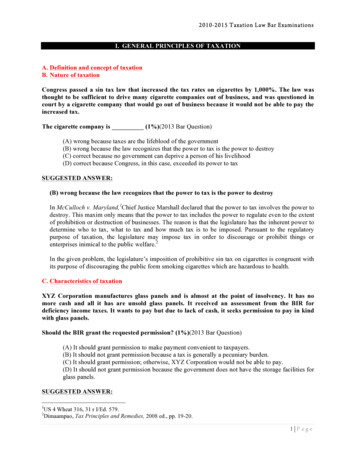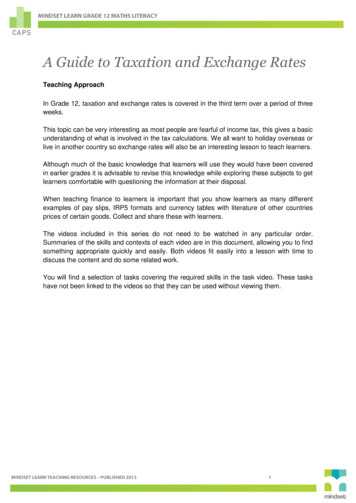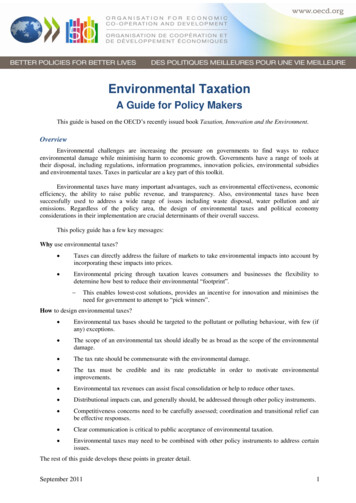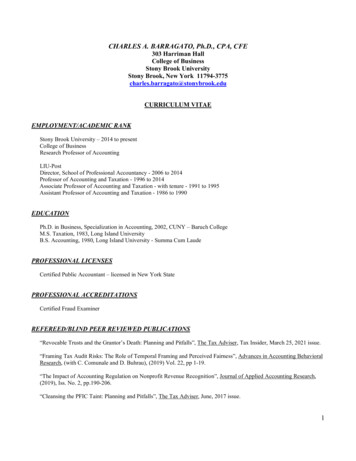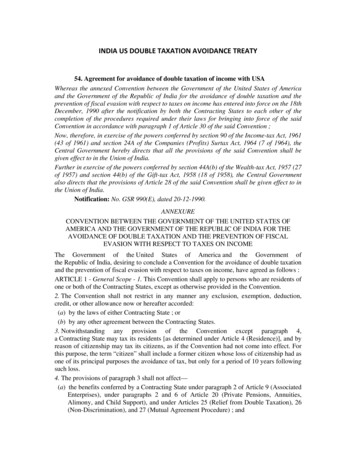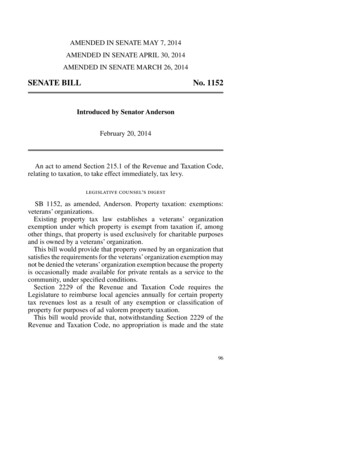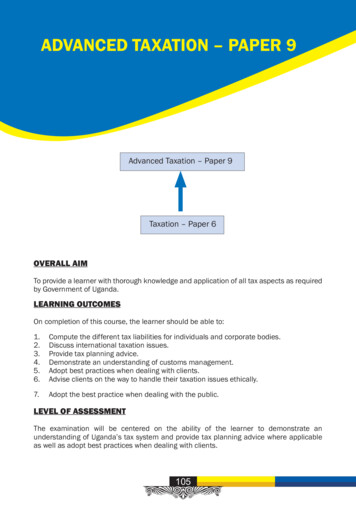
Transcription
ADVANCED TAXATION – PAPER 9Advanced Taxation – Paper 9Taxation – Paper 6OVERALL AIMTo provide a learner with thorough knowledge and application of all tax aspects as requiredby Government of Uganda.LEARNING OUTCOMESOn completion of this course, the learner should be able to:1.2.3.4.5.6.Compute the different tax liabilities for individuals and corporate bodies.Discuss international taxation issues.Provide tax planning advice.Demonstrate an understanding of customs management.Adopt best practices when dealing with clients.Advise clients on the way to handle their taxation issues ethically.7.Adopt the best practice when dealing with the public.LEVEL OF ASSESSMENTThe examination will be centered on the ability of the learner to demonstrate anunderstanding of Uganda’s tax system and provide tax planning advice where applicableas well as adopt best practices when dealing with clients.105
EXAMINATION STRUCTUREThere will be a three hour examination made up of sections A and B. Section A will compriseof one compulsory question of 40 marks. Section B will comprise of four questions of 20marks each, of which the candidate will be required to attempt any three.DETAILED SYLLABUSA. TAXATION OF BUSINESS INCOME – CORPORATE BODIES1.Meaning of: taxable person, chargeable income, gross income, year of income,assessed losses, allowable expenses, non-allowable expenses2.Revenue versus capital expenditure3.Exclusivity clauses for expenses:(a) Allowable (deductible)/ and non-allowable (non-deductible) expenses4.(b) Treatment of items such as bad debts, entertainment, repairs and maintenance,donations, assessed losses, legal and professional expensesTreatment of tax losses:(a) Carry forward of losses5.(b) The number of years tax losses are required to be carried forwardComputation of taxable profits and determination of chargeable income6.Computation of corporation tax liability7.Taxation of group companies:(a) Roll over relief(b) Liquidation8.(c) Re-organisationsExempt income and exempt organisations: Meaning and examples of eachB. CAPITAL ALLOWANCES (DEDUCTIONS)1.Meaning and scope of capital allowances:(a) Wear and tear(b) Initial allowance(c) Farm works(d) Industrial building allowance(e) Start up costs(f)Farm works(g) Allowances for scientific research(h) Mining allowance106
2.Computation of:(a) Depreciation allowances (wear and tear) for depreciable assets and industrialbuildings(b) Capital allowances for intangible assets(c) Initial allowance – depreciable assets and industrial buildings(d) Farm works allowances(e) Allowances for mining/ mineral exploration(f)Start up costs/ horticultural expenditure/ farm worksC. CAPITAL GAINS TAX1.Meaning and scope of capital gains tax:(a) Business assets(b) Cost base of an asset(c) Disposal of an asset(d) Gains or losses from disposal(e) Cost base of a non-arms length disposal(f)2.Part disposal of an asset, disposal by exchange, disposal by way of gift, deemeddisposal by destructionTreatment of asset disposal under non-arms length transactions3.Non-recognition of gains or losses – involuntary disposal4.Transitional provisions regarding capital gains tax:(a) Market value of property as at 31 March 1998(b) Value of property by the chief government valuer5.(c) Cost base of an asset under certificate of incentivesComputation of capital gains tax on various disposals6.Tax planning and capital gains taxD. EMPLOYMENT INCOME1.Concept of employment income:(a) Employee versus employer(b) Residence status of an employee(c) Resident employee versus non-resident employee2.(d) Taxation as per the Income Tax ActScope and composition of employment income3.Valuation of benefits in kind4.Exempt benefits107
5.Computation of employment tax liabilityE. PROPERTY INCOME1.Taxation aspects of property income2.Types of property income: royalties, dividends, interest income, annuities, naturalresource payments, rents3.Computation of property tax liabilityF.INDIVIDUAL INCOME TAX – BUSINESS INCOME1.Scope of business income of an individual: gross income, chargeable income2.Allowable and non-allowable deductions of an individual3.Computation of chargeable income of an individual and tax payableG. TAXATION OF PARTNERSHIPS1.Meaning of partnership2.Principles behind taxation of partnerships:(a) Residence rules(b) Partnership income(c) Profit appropriation(d) Treatment of salaries(e) Interest on capital(f)Drawings(g) Partners’ loans(h) Contribution of business assets and non business assets3.(i) Limited liability partnershipsComputation of chargeable income of a partnership4.Computation of chargeable income and tax liabilities of a partner5.Tax implications of reconstructed partnerships; dissolution, admission of new partners,change in the structureH. VALUE ADDED TAX (VAT)1.Meaning of output and input VAT2.Treatment of output VAT:(a) Bad debts(b) Returned goods108
3.(c) DiscountsTreatment of input VAT:(a) Unclaimed VAT(b) VAT on imported services(c) Time limit of claim for input VAT4.(d) Methods of apportionment of input taxPenalties for non submission of returns5.Credit of input VAT where a taxable person deals in both exempt and taxable supplies6.Input tax claimable/ non claimableI.OFFENCES AND PENALTIESOffences and penalties- under the ITA, VAT Act and the East Africa CustomsManagement ActJ.OBJECTIONS AND APPEALS1.Meaning of appeals and objections2.Procedures:(a) Deadlines, tax payable, taxes not in dispute etc under the Income Tax Act andValue Added Tax Act and the Customs Laws3.(b) Tax payer’s rights and obligationsAppeals procedure: Tax Appeals Tribunal and High CourtK. ANTI AVOIDANCE RULES1.Transactions between associates:(a) Meaning2.(b) Implications on the taxation of multinational organisationsCommissioners powers regarding non-arms length transactions3.Re-characterisation of income and deductions between associates by the commissioner4.Thin capitalisation rules under anti-avoidance rules5.Methods of determining arms length price6.International agreements: Organisations for Economic Cooperation and Development(OECD) and UN Model treaties109
L. INTERNATIONAL TAXATION1.International transfer pricing:2.(a) Importance(b) OECD guidelines on transfer pricingResidence in international taxation: source rules, country of vital interest3.Taxation of branches:4.(a) Principles(b) Determination of branch profits and tax on repatriated incomeTaxation of international payments:5.(a) Technical fees(b) Professional fees(c) Management fees(d) Interest on foreign loansTax reliefs under international taxation:6.(a) Unilateral agreements(b) Bilateral agreements (relief under double taxation)Statutory provisions on international agreements7.Priority rule versus anti-treaty shopping rule8.Withholding tax (WHT):(a)(b)(c)(d)(e)Withholding agentsCircumstances under which WHT is a final taxImplications of taking withholding tax as a final taxDetermination of WHT on various paymentsPayment of WHT and the penalty if this tax is not paidM. TAXATION OF PETROLEUM OPERATIONS1.Meaning and Scope:(a)(b)(c)(d)(e)(f)(g)(h)(i)Contract areaCommercial productionContractorCost oilDelivery pointDevelopment planExploration expenditurePetroleum agreement, operations, and revenuesRecoverable costs110
2.(j) Sub-contractorTaxation of contractors and sub-contractors3.Limitation on deductions4.Decommissioning costs reserve and decommission expenditure5.Allowable contract expenditure and unrecoverable costs6.Gain or loss on transfers7.Transfers of interest under petroleum agreements8.Withholding tax9.Accounting principles10. Returns11. Credits under petroleum agreementsN. TAX PLANNING1.Meaning2.Key areas of tax planning: structure of business set up, choosing where to locate abusiness, choosing a sector where to set up business3.Other tax planning ideas which a taxpayer can benefit from under the different taxheads: income tax, customs tax, capital gains taxO. CUSTOMS MANAGEMENT AND PROCEDURES1.Duty drawback:2.(a) Meaning(b) Claiming(c) DocumentationExport Processing Zone (EPZ)3.(a) Meaning(b) Removal of goods from EPZ(c) Designation of goodsProhibitions and restrictions under customs management:(a) Powers to prohibit4.(b) Restricted goods:(i) Reasons for restriction(ii) Examples(c) Exemptions of goods in transitCustoms offences and procedures:111
5.6.(a) Types(b) Seizures and forfeitures(c) Procedures(d) Penalties and settlement.Transitional arrangements under customs management:(a) Meaning:(i) International tariffs(ii) Common external tariffs(iii) Common internal tariffs(iv) Zero tariffs(b) Rules of origin:(i) Meaning(ii) Criteria used in determining rules of origin(iii) Exceptions to the rules of origin criteriaTax treatment of goods deemed to originate from the partner states as per the EastAfrican Customs Union7.Customs valuation and computation of duty8.Importance of International Customs Organisations:(a) Common Markets for East and Southern Africa(b) South African Development Cooperation(c) World Trade Organisation(d) UN model treatyETHICAL ISSUES1.Dealing with tax issues ethically2.Importance of acting with integrity and the consequences of tax avoidanceREFERENCES1.Bahemuka Pius K (2012): Income Tax in Uganda, The New Vision Printing andPublishing Company Ltd. 3rd Edition2.Bahemuka Pius K (2011): Value Added Tax in Uganda3.Mugume Christine (2014): Managing Taxation in Uganda, CMK Consulting, Kampala,Uganda, 2nd Edition4.The Government of Uganda: The Income Tax Act, Cap 340, Government of Uganda5.The Government of Uganda: Value Added Tax, Cap 349, Government of Uganda6.The Government of Uganda: Customs & Excise Act, Cap 335, Government of Uganda112
109 (c) Discounts 3. Treatment of input VAT: (a) Unclaimed VAT (b) VAT on imported services (c) Time limit of claim for input VAT (d) Methods of apportionment of input tax

